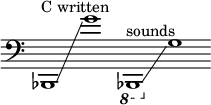 Contrabass sarrusophone in E♭ | |
| Woodwind instrument | |
|---|---|
| Classification | |
| Hornbostel–Sachs classification | 422.112 (Double reed aerophone with keys) |
| Inventor(s) |
|
| Developed | Mid 19th century |
| Playing range | |
  | |
| Related instruments | |
| Builders | |
Historical: | |
| More articles or information | |
| Sarrusophones: | |
The contrabass sarrusophone is the deepest of the family of sarrusophones, built in three sizes pitched in E♭, C or B♭. It was made in the 19th and early 20th centuries, primarily in France by its inventor and Parisian instrument maker Pierre-Louis Gautrot and his successor Couesnon & Co., and Evette & Schaeffer. It was also made in Italy by Milan manufacturers Romeo Orsi and Rampone & Cazzani, and in the United States by C. G. Conn, who built instruments in E♭ for US military bands.[1] Romeo Orsi and the German instrument maker Benedikt Eppelsheim make individual contrabass sarrusophones on request.[2][3]
- ^ a b Blaikley, D. J. (2001). "Sarrusophone". Grove Music Online (8th ed.). Oxford University Press. doi:10.1093/gmo/9781561592630.article.24597. ISBN 978-1-56159-263-0.
- ^ "Instruments Made on Request". Milan: Romeo Orsi. Archived from the original on 18 June 2009.
- ^ "Custom Made". Munich: Benedikt Eppelsheim Wind Instruments. Archived from the original on 22 June 2017. Retrieved 11 November 2022.